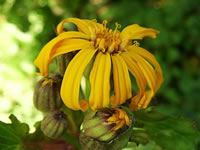Planting, Growing and Caring for Leopard Plants
Ligularia
           
|

|
Ligularias are known by many interchangeable names... Leopard Plant, Ragwort and Golden Groundsel to name a few. They are unusual, old world perennials with big leaves with long leaf stalks and unique daisy-like flowers.
They are excellent specimen plants for growing in tubs, boggy areas
or along the banks of stream or pond.
Growing Requirements for Ligularia Plants
The ideal location for growing most Ligularias is in a bog garden with fertile, humus-rich soil in partial shade. In cool zones, they can be grown in full sun to partial shade.
In areas with hot summers, they will need partial to full shade.
Most Ligularias require constantly moist soil.
Ligularias should be divided every 3-4 weeks.
Provide protection from strong winds.
Slugs and snails can be a serious problem so precautions should be taken.
|
Bigleaf Ligularias or Leopard Plants, Ligularia dentata, are hardy in USDA zones 5-8.
They form 3 foot clumps of very large, bronze-green or maroon, kidney shaped leaves that will grow 2-3 feet tall with 3-4 ft. branched spikes of 3", bright yellowish-orange flowers in the early summer. Needs partial to full shade.
Shavalzki's Ligularia, Ligularia przewalskii, are hardy in USDA zones 4-8.
Ligularia przewalskii forms loose, mounding clumps of round, deeply cut, dark green leaves. They produce 6 ft., dark purple stalks covered with 1"-1½", bright yellow flowers from early to late summer.
Narrow-spiked Ligularia or 'The Rocket', Ligularia stenocephala, are hardy in USDA zones 4-8.
They are similar to L. przewalski except that they form lower growing mounds of 12", heart to triangular shaped foliage. They produce 4-6 ft. spikes of 1½" lemon yellow flower spikes in late summer.
Giant Groundsel, Ligularia wilsoniana are hardy in USDA zones 5-8. They form 3 ft. mounds of dark green, kidney shaped foliage and produce 4-6 ft. stalks of Daisy-like yellow flowers in mid to late summer.
How to Propagate new Ligularia Plants
Ligularia plants can be propagated by division in early spring.
Ligularias self sow readily. These seedlings can be transplanted to other areas of the garden.
Seeds can be sown directly in the garden in the spring or fall. |
|

Ligularia dentata
|

Ligularia przewalski |
|
|
|
|
Search The Garden Helper:


